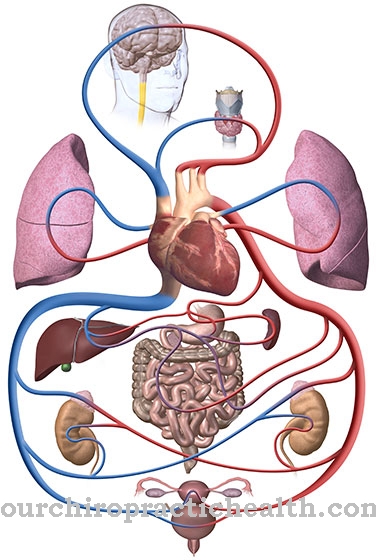As Engelmann syndrome is called a rare form of osteosclerosis. It is associated with a reduction in bone resilience and other symptoms and can be treated with various medications.
What is Engelmann Syndrome?

© sveta - stock.adobe.com
Engelmann syndrome is a form of osteosclerosis that was discovered by the German physiologist Theodor Wilhelm Engelmann. It is characterized by a number of symptoms such as increasing bone hardening and a simultaneous reduction in bone resilience.
Since the disease is caused by a gene mutation, prevention in the classic sense is not possible. After a comprehensive diagnosis, including various x-ray examinations, those affected can, however, be treated with various drugs. If this happens early, a positive course of the disease can be expected.
However, if the treatment is delayed, the symptoms spread to the base of the skull, which can lead to blindness, facial paralysis and deafness. On the other hand, the narrowing of the nerve channels can, in the worst case, damage the brain.
causes
Engelmann syndrome is caused by a mutation on chromosome 19. More precisely, by a change in the 19q13.1-13.3 gene locus, which damages the so-called transforming growth factor. Here again, the beta-1 chain of the molecule is defective. Since the TFG is responsible for the formation of the bones, abnormalities in the bones and other disorders result in the event of a genetic error.
The symptoms can vary greatly from one carrier to another, which is why a comprehensive diagnosis is all the more important. The gene mutation is inherited as an autosomal dominant trait, but there are also sporadic cases. So it is possible that the mutation skips a generation, whereby humans continue to serve as carriers and inherit the faulty gene.
You can find your medication here
➔ Medicines for painSymptoms, ailments & signs
People who suffer from Engelmann syndrome already struggle with serious symptoms in early childhood. Shortly after birth, scleroses and hyperostoses develop on the long bones. Initially, only the lower legs are affected before the disease spreads to other bones and, if left untreated, ultimately affects the entire bone structure.
Since the bony nerve canals are also affected in the later course of the disease, cranial nerve palsy occurs and this in turn leads to further symptoms and secondary diseases. Visual impairment and deafness can occur as well as total blindness and facial paralysis. The intelligence remains unaffected by this, but headaches, symptoms of fatigue and difficulty concentrating occur, especially in children.
In addition, puberty often sets in late. Bone pain also occurs, there are problems walking, and those affected suffer from hypotension of the limb muscles. In addition, there are inherent diseases of the muscles, also known as myopathy.
This often leads to anemia and leukopenia and, depending on the clinical picture, to other symptoms. Raynaud's syndrome, a vascular disease that can be recognized by the blue color of the fingers and pale skin, occurs particularly frequently.
Diagnosis & course
The diagnosis of Engelmann syndrome is made through x-ray examinations. This allows typical signs such as enlarged medullary cavities and an unusual thickening of the cortical layer on the affected long bones to be determined. Various tests are also carried out to rule out other osteoscleroses such as craniodiaphyseal dysplasia.
However, due to the high variability of the symptoms and their severity, this does not always succeed, which is why an additional medical history is necessary. This focuses on similar illnesses in the family of the person affected, whereby the first appearance of the symptoms and other special features are also taken into account. An illness diary can be a useful addition to the anamnesis.
Furthermore, in a conversation between the doctor and the patient, it is clarified how severe the pain is, where it occurs and whether the paralysis symptoms mentioned have already occurred. This makes it possible, on the one hand, to determine whether it is Engelmann's syndrome and, on the other hand, to clarify the stage of the disease. The course of the disease is generally rated rather positively.
With early treatment, the clinical and radiological abnormalities can be treated comprehensively, with secondary symptoms such as short stature being not uncommon. If the disease is not treated, other bones will later develop and the base of the skull will eventually be affected. If nerves are pinched here, neurological deficits and other, sometimes fatal symptoms are the result.
Complications
As a rule, the resilience of the bones is reduced in Engelmann syndrome. Even minor accidents or impacts can lead to fractures. The patient is restricted in his everyday life and cannot carry out any physically difficult work.
Most patients experience the first complications immediately after birth. Sclerosis forms in the process. The disease spreads to other bones over the course of life, and eventually the entire body. Engelmann syndrome also has a negative effect on eyesight and hearing. Complete deafness can result.
Blindness does not usually occur. There are no spiritual restrictions in the patient, so that thinking and acting are possible in the usual way. Because of the pain in the bones, many people also experience pain when walking. This leads to an unnatural gait that other people can find bizarre.
Children and young people in particular are bullied because of this. Treatment is possible by adding steroids. However, often not all symptoms of Engelmann syndrome can be combated. In addition to drug treatment, physiotherapy can also be helpful and support it.
When should you go to the doctor?
Children who suffer from Engelmann syndrome must receive medical treatment from an early age. Most of the time, the disease is diagnosed immediately after birth and therapy is initiated immediately. Further visits to the doctor are required if complications arise or unusual symptoms and complaints arise.
In the event of sudden headaches, difficulty concentrating or symptoms of fatigue, you should definitely speak to your pediatrician or family doctor.
If the typically occurring scleroses and hyperostoses cause movement restrictions, it is best to consult an orthopedic surgeon or chiropractor. At the first signs that the disease has spread to other bones, the child must be taken to a specialist clinic.
Immediate medical clarification is also required with severe bone pain, problems walking and secondary diseases such as anemia or leukopenia. If there are signs of Raynaud's syndrome, a specialist in vascular diseases must be called in. As the affected children and their parents often also suffer psychologically from Engelmann syndrome, therapeutic advice should be sought.
Doctors & therapists in your area
Treatment & Therapy
Engelmann syndrome is treated with corticosteroids. These lead to a normalization of the various abnormalities, but also trigger short stature and other side effects. There is also the risk of Cushing's disease. This syndrome is caused by an increased use of certain drugs and leads to muscle weakness, trunk obesity and various other symptoms.
No other treatment options besides the administration of cortisone are known. However, it is possible to treat existing bone damage through surgery. Physiotherapy can also contribute to recovery, but under normal circumstances existing bone damage cannot be completely reversed.
Outlook & forecast
With Engelmann syndrome, the prognosis is not particularly good because of the progressive disease. The prospects are slightly better with the weaker variant of Engelmann's syndrome, the so-called ribbing syndrome.
The consequences of the osteosclerosis that have occurred weigh heavily on those affected. Generalized bone hypertrophy results in increasing bone hardening. This in turn leads to a lack of flexibility and resilience in the bones. The genetic consequences of the disease cannot be revised. Those affected have to learn to live with severe pain, restricted mobility and muscle weakness and general fatigue.
The prospects are better if the person affected is a carrier of the mutated gene but does not suffer from Engelmann syndrome. However, he then becomes the carrier of the genetic defect to his offspring. Since the consequences of the disease manifest themselves in childhood, there is hardly anything that can be done to counter the progression of the disease. The frequent accompanying vascular diseases make Engelmann syndrome more difficult.
The prognosis is improved by the early administration of corticosteroids. However, this can cost the price of a short stature. A pituitary tumor (Cushing's disease) can also develop. The benefits and risks of such symptomatic treatment approaches must therefore be carefully weighed.
Since the disease progresses despite all measures, the prospects for those affected are not too rosy. Medicine currently has hardly any means available to alleviate the symptoms of Engelmann syndrome.
You can find your medication here
➔ Medicines for painprevention
Engelmann syndrome cannot yet be prevented because it is a disorder of the genes. The only way to prevent it is to diagnose a mutation in the fetus. Appropriate measures such as the administration of medication can then be initiated at an early stage, thereby reducing long-term damage to a minimum.
From this onwards, those affected can at least largely prevent accompanying symptoms through physiotherapy, sport and the use of the drugs mentioned.
Aftercare
Follow-up care measures are very limited in Engelmann syndrome. Since a complete cure cannot be achieved, the focus of the treatment is the early diagnosis and the early initiation of treatment. This is the only way to prevent further complications and complaints.
In most cases, patients are dependent on medication and steroids. Serious complications rarely occur, but those affected should always ensure that the medication is taken correctly and regularly. The doctor's instructions should also be observed, and a doctor should also be consulted in case of doubt or other uncertainties.
In many cases, those affected are also dependent on rehabilitation measures such as physiotherapy. This should be done regularly. Many exercises from physiotherapy or physiotherapy can also be performed in your own home. This may speed up the healing process for the person affected.
The patients are usually also dependent on regular examinations by a doctor. This is the only way to prevent further complications. It cannot be universally predicted whether Engelmann syndrome will lead to a reduced life expectancy. In some cases, contact with other sufferers of the syndrome can also be useful.
You can do that yourself
So that the patient can keep his freedom of movement for as long as possible, targeted movements and training should be carried out. These can be used independently several times a day. Often, small exercise units within the daily routines and processes are sufficient to strengthen the organism.
Overloading and overexertion are to be avoided in principle. All movements are to be adapted to the current physical possibilities. Since these change in the course of the disease, they must be regularly adapted to the circumstances. The patient should never overstrain himself or expose himself to a great risk of falling. Unilateral loads, bad posture or rigid body positions are to be avoided in all movement sequences. The skeletal system needs balancing positions and, in addition, a sufficient supply of heat.
If the patient has poor eyesight or is blind, everyday life and the spatial conditions should be adapted to his needs. The risk of accidents must be minimized and daily help is required for the performance of various tasks.
Conversations with psychologists, relatives and friends can be important for mental strengthening. In addition, many patients find participation in self-help groups pleasant and beneficial. The exchange with other sick people offers mutual support. Experiences can be discussed and tips for dealing with the disease in everyday life are given.


.jpg)

.jpg)








.jpg)

.jpg)
.jpg)











.jpg)